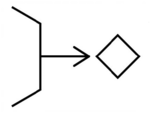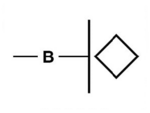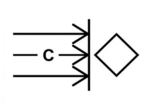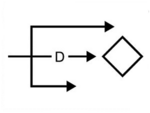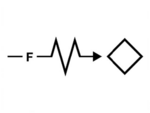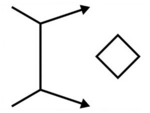Symboliken und Taskverbs: Unterschied zwischen den Versionen
Zur Navigation springen
Zur Suche springen
| Zeile 104: | Zeile 104: | ||
!Bezeichnung | !Bezeichnung | ||
!Beschreibung | !Beschreibung | ||
! | |||
|- | |- | ||
|[[Datei:Attack by fire.png|150x150px]] | |[[Datei:Attack by fire.png|150x150px]] | ||
|Attack by fire | |Attack by fire | ||
|Attack by fire ist eine taktische Missionsaufgabe, bei der direktes und indirektes Feuer, um einen Feind aus der Entfernung zu bekämpfen. | |Attack by fire ist eine taktische Missionsaufgabe, bei der direktes und indirektes Feuer, um einen Feind aus der Entfernung zu bekämpfen. | ||
|<!-- B-3. Attack by fire is a tactical mission task using direct and | |||
indirect fires to engage an enemy from a distance. Friendly forces | |||
use direct fires, supported by indirect fires, to engage an enemy force | |||
without closing with the enemy to destroy, suppress, fix, or deceive | |||
that enemy. This task is usually given when the mission does not | |||
dictate or support occupation of the objective. An attack by fire is | |||
not done in conjunction with a maneuvering force. When assigning | |||
this task, the commander must state the desired effect on enemy | |||
forces, such as neutralize, fix, or disrupt. A commander may assign | |||
the force conducting an attack by fire to a battle position with either | |||
a sector of fire or an engagement area. The arrow points at the | |||
targeted force or objective, and the commander places the base of the arrow in the general area from which | |||
the commander wants to deliver the attack. Attack by fire positions are rarely applicable to units larger than | |||
company size. Figure B-1 on page B-1 depicts the attack by fire tactical mission task. | |||
B-4. An attack by fire closely resembles the task of support by fire. The chief difference is that one unit | |||
conducts the support by fire task to support another unit, so the second unit can maneuver against enemy | |||
forces. The attack by fire task includes— | |||
Assigning sectors of fire or engagement areas to each subordinate weapon system to include the | |||
enemy force’s defensive positions or avenues of approach. | |||
Designating control measures for massing, distributing, and shifting of direct and indirect fires. | |||
Designating BPs, an assigned area, or an axis of advance to allow the friendly force to engage the | |||
enemy force. | |||
Providing for security and all-around defense, including control measures to ensure tie in of | |||
subordinate elements and maximum use of hide positions. | |||
Using OPSEC to deceive enemy forces about movement, occupation, and intent of the operation. | |||
Reconnoitering, preparing, and securing movement routes and firing positions before the | |||
movement of the main body, and stocking class V items. | |||
Providing movement instructions to the initial battle positions --> | |||
|- | |- | ||
|[[Datei:Block.png|rahmenlos|150x150px]] | |[[Datei:Block.png|rahmenlos|150x150px]] | ||
|Block | |Block | ||
|Block ist eine taktische Missionsaufgabe, die dem Feind den Zugang zu einem Gebiet oder einem Zugangsweg verwehrt. | |Block ist eine taktische Missionsaufgabe, die dem Feind den Zugang zu einem Gebiet oder einem Zugangsweg verwehrt. | ||
|<!-- B-5. Block is a tactical mission task that denies the enemy access to | |||
an area or an avenue of approach. A blocking task normally requires | |||
the friendly force to block the enemy force for a certain time, or until a | |||
specific event has occurred. The line perpendicular to the enemy’s line | |||
of advance indicates the limit of enemy advance. A blocking unit may | |||
have to hold terrain and become decisively engaged. Block as a tactical | |||
mission task differs from the tactical mission task of fix. A blocked | |||
enemy force can move in any direction other than the obstructed one, | |||
while a fixed enemy force cannot move in any direction. Figure B-2 | |||
depicts the block tactical mission task --> | |||
|- | |- | ||
|[[Datei:Clear.png|150x150px]] | |[[Datei:Clear.png|150x150px]] | ||
|Clear | |Clear | ||
|Clear ist eine taktische Missionsaufgabe, bei der eine Einheit alle feindliche Kräfte innerhalb eines zugewiesenen Gebietes vernichtet. | |Clear ist eine taktische Missionsaufgabe, bei der eine Einheit alle feindliche Kräfte innerhalb eines zugewiesenen Gebietes vernichtet. | ||
|<!-- B-16. Clear is a tactical mission task in which a unit eliminates all | |||
enemy forces within an assigned area. Friendly forces do this by | |||
destroying, capturing, or forcing the withdrawal of enemy forces, so they | |||
cannot execute organized resistance and interfere with the friendly unit’s | |||
mission. In all cases, this task requires a thorough reconnaissance to | |||
discover the enemy force’s locations. After discovering the enemy | |||
force’s location, the clearing force maneuvers against the enemy force. | |||
The bar connecting the arrows designates the desired limit of advance | |||
for the clearing force. The bar also establishes the width of the area to | |||
clear. Figure B-8 depicts the clear tactical mission task. | |||
B-17. This task requires significant time and other resources. In the | |||
mission statement, a commander can modify the objective associated with this task to destroying, capturing, | |||
or forcing the withdrawal of only enemy forces larger than a stated size. In this case, the clearing force keeps | |||
smaller enemy forces under observation, while the rest of the friendly force bypasses them. | |||
B-18. Clear is also a mobility task that involves the total elimination of an obstacle that is usually performed | |||
by follow-on engineers and is not done under fire. Units conduct clearing operations to eliminate completely | |||
the enemy’s obstacle effort or the residual obstacles affecting the operational area. (See FM 3-90.4 for more | |||
information on mobility clearing operations. --> | |||
|- | |- | ||
|[[Datei:Destroy.png|64x64px]] | |[[Datei:Destroy.png|64x64px]] | ||
|Destroy | |Destroy | ||
|Destroy ist eine taktische Missionsaufgabe, die eine gegnerische Streitkraft physisch gegnerische Streitkräfte bis zu ihrer Wiederherstellung kampfunfähig macht. | |Destroy ist eine taktische Missionsaufgabe, die eine gegnerische Streitkraft physisch gegnerische Streitkräfte bis zu ihrer Wiederherstellung kampfunfähig macht. | ||
|<!-- B-23. Destroy is a tactical mission task that physically renders an | |||
enemy force combat-ineffective until it is reconstituted. | |||
Alternatively, to destroy a combat system is to damage it so badly that it | |||
cannot perform any function or be restored to a usable condition without | |||
being entirely rebuilt. The amount of damage needed to render a unit | |||
combat ineffective depends on the unit’s type, discipline, and morale. | |||
Destroying armored or dug in targets with area fire weapons requires | |||
considerable ammunition and time, so forces do not normally attempt it | |||
unless they have terminally guided munitions. Figure B-11 depicts the | |||
destroy tactical mission task. --> | |||
|- | |- | ||
|[[Datei:Disrupt.png|150x150px]] | |[[Datei:Disrupt.png|150x150px]] | ||
|Disrupt | |Disrupt | ||
|Disrupt ist eine taktische Missionsaufgabe, bei der eine Einheit die Formation oder das Tempo des Gegners stört und die gegnerische Truppe dazu bringt vorzeitig oder bruchstückhaft anzugreifen. | |Disrupt ist eine taktische Missionsaufgabe, bei der eine Einheit die Formation oder das Tempo des Gegners stört und die gegnerische Truppe dazu bringt vorzeitig oder bruchstückhaft anzugreifen. | ||
|<!-- B-29. Disrupt is a tactical mission task in which a unit upsets an | |||
enemy’s formation or tempo and causes the enemy force to attack | |||
prematurely or in a piecemeal fashion. Units disrupt an enemy force | |||
by integrating direct and indirect fires, terrain, and obstacles. This | |||
increases an enemy force’s vulnerability to friendly fires. It may | |||
temporarily knock a unit out of a battle. Disruption is not an end; it is | |||
the means to an end. The center arrow points toward the targeted enemy | |||
unit. Figure B-13 depicts the disrupt tactical mission task. | |||
B-30. The maneuver force attempting to disrupt an enemy force must | |||
attack the defending enemy force with enough combat power to achieve | |||
the desired results with one mass attack or sustain the attack until it | |||
achieves the desired results. It may involve attacking the enemy force while it is still in its assembly areas oin an approach march before it can deploy into a movement formation. A commander determines the degree | |||
of acceptable risk based on anticipated friendly losses, the location of the attack, the number of attacks, and | |||
other risk management factors. --> | |||
|- | |- | ||
|[[Datei:FIX.png|150x150px]] | |[[Datei:FIX.png|150x150px]] | ||
|Fix | |Fix | ||
|Fix ist eine taktische Missionsaufgabe, bei der eine Einheit den Feind für einen bestimmten Zeitraum daran hindert, sich von einem bestimmten Ort aus zu bewegen | |Fix ist eine taktische Missionsaufgabe, bei der eine Einheit den Feind für einen bestimmten Zeitraum daran hindert, sich von einem bestimmten Ort aus zu bewegen | ||
|<!-- B-35. Fix is a tactical mission task in which a unit prevents the | |||
enemy from moving from a specific location for a specific period. | |||
This may occur by engaging an enemy force to prevent its withdrawal | |||
for use elsewhere, or by using deception, such as transmitting false | |||
orders. A commander uses fix in offensive and defensive actions; it is | |||
always a supporting effort. The point of the arrow faces toward the | |||
desired enemy unit to fix. The broken part of the arrow indicates the | |||
desired location for that event to occur. Figure B-16 depicts the fix | |||
tactical mission task. | |||
B-36. Fixing an enemy force does not mean destroying it. The friendly | |||
force has to prevent the enemy force from moving in any direction. This | |||
task usually has a time constraint, such as “fix the enemy reserve force until OBJECTIVE FALON is | |||
secured.” The tactical mission task of fix differs from that of block in that a fixed enemy force cannot move | |||
from a given location, but a blocked enemy force can move in any direction other than the one obstructed --> | |||
|- | |- | ||
|[[Datei:Penetrate.png|rahmenlos|64x64px]] | |[[Datei:Penetrate.png|rahmenlos|64x64px]] | ||
|Penetration | |Penetration | ||
| Der Auftrag die feindlichen Linien zu durchbrechen. | | Der Auftrag die feindlichen Linien zu durchbrechen. | ||
| | |||
|- | |||
| | |||
|Retain | |||
| | |||
|<!-- B-55. Retain is a tactical mission task in which a unit prevents | |||
enemy occupation or use of terrain. A commander assigning this task | |||
specifies the area to retain and the duration of the retention, which is | |||
time or event driven. While a unit is conducting this task, it expects | |||
enemy forces to attack and prepares for decisive engagement. A unit | |||
tasked to retain a specific piece of terrain does not necessarily have to | |||
occupy it. The direction of the arrow has no significance, but the symbol | |||
includes the entire area to be retained. Figure B-24 depicts the retain | |||
tactical mission task --> | |||
|- | |- | ||
|[[Datei:SFP.png|rahmenlos|150x150px]] | |[[Datei:SFP.png|rahmenlos|150x150px]] | ||
|Support by fire | |Support by fire | ||
|Support by fire ist eine taktische Missionsaufgabe, bei der eine Einheit den Feind mit direktem Feuer angreift, um eine andere manövrierenden Truppe. | |Support by fire ist eine taktische Missionsaufgabe, bei der eine Einheit den Feind mit direktem Feuer angreift, um eine andere manövrierenden Truppe. | ||
|<!-- B-40. Support by fire is a tactical mission task in which a maneuver force moves to a position where it can | |||
engage the enemy by direct fire in support of another maneuvering force. The primary objective of the support | |||
force is normally to fix and suppress the enemy so that the enemy cannot effectively fire on the maneuvering force. | |||
The secondary objective is to destroy the enemy if the enemy tries to reposition. The commander specifies the | |||
desired effect on the enemy when assigning this task. | |||
B-41. A unit conducting the task of support by fire does not maneuver to capture enemy | |||
forces or terrain. The commander gives this task to another unit as part of a larger maneuver. | |||
When assigning a support by fire mission, the commander designates the enemy, when to | |||
attack, the general location from which to operate, the friendly force to support, and the | |||
purpose of the task, such as fix or suppress. (Figure B-12 shows the tactical mission graphic | |||
for support by fire.) The ends of the arrows point in the general direction of the targeted unit or | |||
location. The base of the area indicates the general area from which to deliver fires. | |||
B-42. Once the commander gives an element the task of support by fire, it should occupy | |||
support by fire positions that have cover and concealment, good observation, and clear fields | |||
of fire. Elements occupying support by fire positions should— | |||
Check the security of the position. | |||
Search for targets. | |||
Orient weapons on likely or suspected enemy positions. | |||
Assume fighting positions that provide some degree of protection. Armored and Stryker equipped forces | |||
occupy hull-down firing positions, while infantry forces use trees, natural berms, buildings, and similar | |||
existing terrain features. | |||
Assign observation sectors to each Soldier or weapon system in the support by fire element. | |||
Use available thermal sights to locate heat sources not visible to the naked eye, such as vehicles | |||
concealed in tree lines or other wooded areas or personnel serving at observation posts (OPs). | |||
B-43. Support by fire closely resembles the task of attack by fire. The difference is that support by fire supports | |||
another force so that it can maneuver against the enemy, while an attack by fire does not support the maneuver of | |||
another friendly force. --> | |||
|- | |- | ||
| | |||
| | | | ||
| | | | ||










